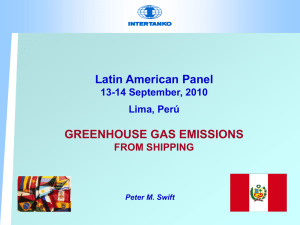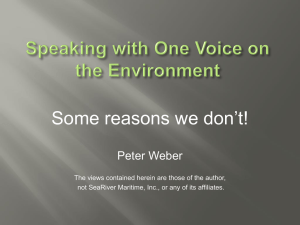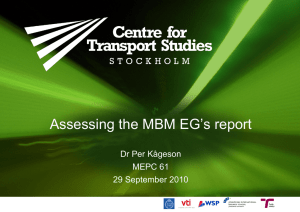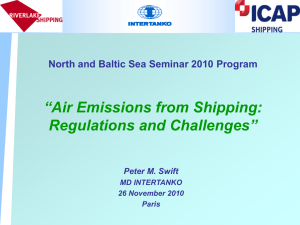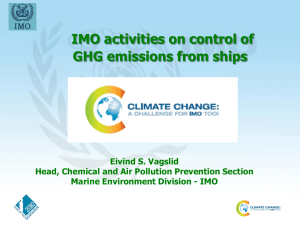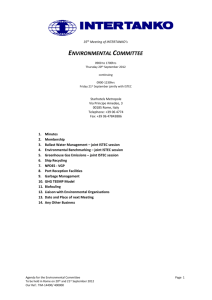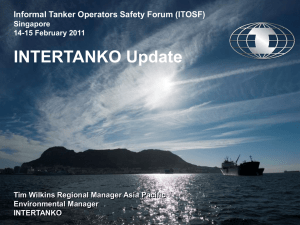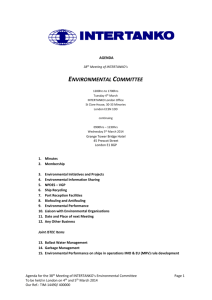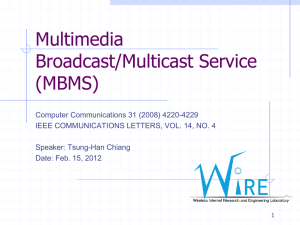EEDI - Intertanko
advertisement
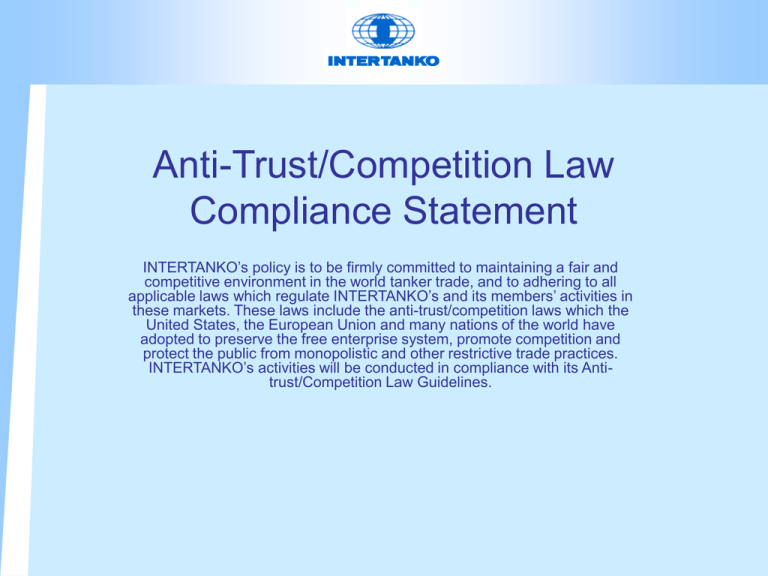
Anti-Trust/Competition Law Compliance Statement INTERTANKO’s policy is to be firmly committed to maintaining a fair and competitive environment in the world tanker trade, and to adhering to all applicable laws which regulate INTERTANKO’s and its members’ activities in these markets. These laws include the anti-trust/competition laws which the United States, the European Union and many nations of the world have adopted to preserve the free enterprise system, promote competition and protect the public from monopolistic and other restrictive trade practices. INTERTANKO’s activities will be conducted in compliance with its Antitrust/Competition Law Guidelines. GREENHOUSE GAS EMISSIONS FROM SHIPS IMO DEVELOPMENTS INTERTANKO Council October 2010 Singapore OUTCOME FROM IMO/MEPC 61 IMO/MEPC 61 intended to: IMO/MEPC 61 agreed to: • Approve a mandatory regulation on Design and Operational measures (EEDI & SEEMP) • Develop further Guidelines for the EEDI formula, calculation of Reference Line and the EEDI verification scheme • Make progress on MBMs, eventually to reduce the number of options • Establish a correspondence group to develop further the EEDI final rule and its associated guideline • Establish an intersessional meeting on MBMs IMO POLITICAL DILEMMAS • Need to reconcile: – UNFCCC principle of Common But Differentiated Responsibility (CBDR) (e.g. EEDI voluntary for ships with developping countries flags?) – IMO principle of No Favourable Treatment (i.e. uniform global rules for shipping) • • • • Design & Operational measures only? Market Based Mechanisms added? Global (UNFCCC) or IMO controlled MBM? New IMO Convention or amendments to MARPOL Annex VI? (is CO2 a pollutant?) EEDI – Proposed Regulation • Applies: Tankers, Bulk Carriers, Gas Tankers, Container Ships, General Cargo Ships & Refrigerated Cargo Carriers • All ships: have a Ship Energy Efficiency Management Plan • For new tankers of > 4,000 DWT • Attained EEDI < Required EEDI • Initial Required EEDI value is calculated with data on ships delivered since 1998 = Reference Line • Required EEDI value will be reduced in time EEDI REQUIRED TANKERS >20,000 DWT Reference Line = Phase 0 = no reduction (2013 & 2014) EEDI IMO impact analysis Phase 1 2015 - 2019 10% 20% Phase 2 2020 - 2024 30% Phase 3 on and after 2025 DWT ISSUES ISTEC WOULD CONSIDER • Proposed regulation (lower size limit for application, definition of ”Major Conversion”, PSC inspections, IEE Certificate form) • Issues related to Guideliens (safety aspects due to cap on installed power & cap on speed, whether some specific designs would potentially be opted out, ”what if” scenarios, e.g. new built non compliant with the required EEDI) MARKET BASED MECHANISMS PROPOSALS TO IMO IMO Expert Group on MBMs REMARKS on MBM SCHEMES • Puropose unclear: emission reduction or collecting funds? • Proposals at different level of maturity • All proposals need further development • All lack policy details with regard to – enforcement – administration – carbon leakage – fraud – vessels registered with non-party flags – harmonisation MBM PROPOSALS • Out of shipping sector mechanisms – International GHG Fund (Denmark et al.) – Emission Trading Scheme (Norway et al.) – Rebate Mechanisms (IUCN) • In shipping sector mechanisms – Leverage Incentive Scheme (Japan) – Ship efficiency & Credit Trading (USA) – Vessel Efficiency System (WSC) – Port State Levy (Jamaica) – Penalty on Trade and Development (Bahamas) MEPC 61 – VIEWS ON MBMs • Opposing MBM - contrary to the CBDR • Opposing ALL proposed schemes but not directly opposing the MBM concept (e.g. China may submit own MBM) • Not opposing the MBM concept but urging further studies on the proposed MBM schemes with particular attention to assessment of cost-impact • Agreeing with the MBM concept but suggesting to narrow down the number of such schemes IMO INTERSESSIONAL ON MBMs • Examine and provide opinion on the compelling need and purpose of MBM as a possible mechanism to reduce GHG • Group the proposed MBMs in accordance with the reduction mechanism they use (e.g. insector/out-of-sector, etc.) • Identify and list strengths and weaknesses for each of the MBM groups • Examine the MBM proposals' relation to the principles and provisions of relevant conventions such as the UNFCCC and its Kyoto Protocol, as well as their compatibility with the WTO Rules and customary international law, as depicted in UNCLOS ISTEC ACTIVITY • Assess the proposed regulation for EEDI & SEEMP • Actively participate to further developments of associated Guidelines for: the EEDI formula, calculation of Reference Line and the EEDI verification scheme • Follow further developments on MBMs and explore additional details of such schemes TIME LINE FOR RULE DEVELOPMENT • • • • • • • • • 27 Sep. - 1 Oct. 10/11 Oct. 12/13 Oct. 29 Nov. – 10 Dec. Feb/March 2011 March/April 2011 May 2011 July 2011 Dec 2011 IMO MEPC 61 ISTEC meeting INTERTANKO Council UNFCCC (COP16) ISTEC meeting IMO intersessional on MBMs INTERTANKO Council IMO MEPC 62 EU deadline for IMO action INDUSTRY INITIATIVES - TEEMP – Tanker Energy Efficiency Management Plan - Virtual Arrival - Industry Study – RT, OCIMF, WSC - OCIMF Trajectory Study INDUSTRY STUDY • Scope: Seek to assess potential reductions of CO2 emissions on a realistic business scenario for 2030 • Realistic scenario: realistic uptake of new technologies and practices • Marginal abatement cost curve vs cost of averting a tonne of CO2 equivalent heating (MACC) • 2009 fleet split in 59 segments • Scrapping and new building assumed • 28 reduction measures Possible Abatement Measures • • • • • • • • • • • • • Gas fuelled engines Electronic engine control Waste heat recovery Air cavity lubrication Contra-rotating propeller Fuels cells as auxiliary engines Frequency converters Exhaust gas boilers on auxiliary engines Energy efficient light systems Wing generator Wind power – kite Wind power – fixed sails or wings Solar panels • • • • • • • • • • • • Trim/draft optimising Weather routing Voyage execution Steam plant operational improvements Speed reduction due to port efficiency Propeller condition Speed reduction due to fleet increase Hull condition Propulsion efficiency devices Cold ironing Engine monitoring Reduced auxiliary power usage OUTCOME (example only) INDUSTRY STUDY • Final results to be assess by industry participants • INTERTANKO and OCIMF should made a joint assessment on results for tankers • Compare with Trajectory Project results • Decision at executive level on the usage of results (go public or not) • Agreement with other stakeholders (including DNV) on how to use the final results Kyoto Protocol Annex I Countries Inventory 1990 - 2007 • 41 Annex I Parties • Total aggregate GHG emissions excluding emissions / removals from land use, land-use change and forestry (LULUCF) decreased by 3.9% • GHG emissions / removals including LULUCF decreased by 5.2 % • For Annex I Parties with economies in transition (Annex I EIT Parties), GHG emissions: – excluding LULUCF decreased by 37% – including LULUCF decreased by 42.2% • For Annex I non-EIT Parties, GHG emissions – excluding LULUCF increased by 11.2 – including LULUCF increased by 12.8% Kyoto Protocol Annex I Countries Inventory 1990 - 2007 Kyoto Protocol Annex I Countries Inventory 1990 - 2007 COUNCIL IS INVITED TO AGREE • ISTEC overviews the proposed EEDI regulation • ISTEC continues its investigations on the associated guidelines to the EEDI regulation • INTERTANKO participates in the IMO correspondence group • INTERTANKO continues to monitor developments on MBMs and attends the IMO intersessional meeting • INTERTANKO continues to cooperate with OCIMF on the Trajectory Project and with other stakeholders for assesement of poetential CO2 emissions reductions. • Secretariat reports at the next meeting when The Council may revisit and eventually update the INTERTANKO Policies on these matters. THANK YOU! • Government's view of the economy could be summed up in a few short phrases: – If it moves, tax it. – If it keeps moving, regulate it. – And if it stops moving, subsidize it. Ronald Reagan (1986) THANK YOU For more information please visit www.intertanko.com dragos.rauta@intertanko.com EEDI REQUIRED TANKERS >20,000 DWT Reference Line = Phase 0 = no reduction (2013 & 2014) EEDI Phase 1 2015 - 2019 10% For tankers between 4,000 & 20,000 dwt Linear progression from 0% to: 10% (Phase 1) 20% (Pahse 2) 30% (Phase 3) 20% Phase 2 2020 - 2024 IMO impact analysis 30% Phase 3 on and after 2025 DWT WHY ARE MBMs PROPOSED • Shipping will become more efficient • IMO will adopt technical measures for new ships (EEDI) • Existing ships will improve their efficiency BUT • CO2 emissions reductions achieved through technical and operational measures may not be sufficient and their effect would not be seen in the near future • Increasing demand for transportation at sea would actually lead to increase of net CO2 emissions from ships even though each ship may become more efficient. INTERNATIONAL GHG FUND EMISSION TRADING SCHEME BAU ETS UNFCCC FUNDS LEVERAGE INCENTIVE SCHEME BASED ON GHG FUND OFFSETING + INCENTIVES LEVY HIGHER NEW BUILDING 5 EEDI Attained Ship 1 Req. EEDI 1 0% Req. EEDI 2 50% Ship 2 Req. EEDI 3 100% 50% Ship 3 5 YEARS 5 YEARS SHIP 1 WILL PAY ENTIRE LEVY SHIP 2 WILL RECEIVE 50 % DISCOUNT ON LEVY FIRST 5 YEARS SHIP 3 WILL RECEIVE - 100% DISCOUNT ON LEVY FOR THE FIRST 5 YEARS - 50% DISCOUNT ON LEVY FOR NEXT 5 YEARS LEVERAGE INCENTIVE SCHEME EEOI benchmark PATERN 1 Actual Initial EEOI PATERN 2 Reduced EEOI EXISTING SHIPS SHIP EFFICIENCY & CREDIT IN SECTOR ONLY SUFFICIENT CREDITS? US EEDI (EIr) Existing ship (EIa) Efficiency Credit = (EIr – EIa) x Activity Efficient Credit >0 = Sells Credits Efficient Credit < 0 = Buys Credits New ship EEDI (US EIa) IMO EEDI WORLD SHIPPING COUNCIL VESSEL EFFICIENCY SYSTEM (VES) • Combination of GHG FUND & US MBM • Emission targets for non EEDI compliant ships only • Sets a reference line less stringent than EEDI • Ship’s efficiency calculated on a formula similar to EEDI • Ships meeting the target = no charges • Less efficient ships = charges/tonne of fuel consumed over the target • IMO establish a Fund to collect charges • Charges proportional to shipping contribution to the total man-made CO2 emissions ATTAINED EEDI ENVIRONMENTAL COST POWER x SFC Attained EEDI ENERGY SAVINGS BENEFIT FOR SOCIETY Capacityx Vref - Cost: Emission of CO2 - Benefit: Cargo capacity transported at a certain distance (Relates to a seagoing maximum condition) - Final Verification at sea trails INTERTANKO COUNCIL POLICY • • • INTERTANKO supports the IMO process to develop real and sustainable regulations to reduce GHG emissions from ships that will not hinder international commerce INTERTANKO supports that the GHG regulations should be "ship neutral" as the only way to address a global environmental issue. Differentiating vessels' GHG obligations on the basis of a vessel's flag would fail to make a meaningful environmental improvement INTERTANKO supports the adoption of the EEDI as soon as possible. INTERTANKO also encourages the IMO to use the EEDI formulae for an early establishment of target levels for CO2 emission reductions for new ships INTERTANKO COUNCIL POLICY • • Shipping is a service industry whose activity increases or contracts with the demands of society. Therefore, INTERTANKO believes that GHG emission reduction targets should give due regard to optimising the supply chain. INTERTANKO believes it is essential that stakeholders and regulators discuss and assess targeting levels for reducing GHG emissions from shipping, on a short- and long-term basis. The target levels should be ambitious, but they should also give realistic predictions and thus provide incentive for sustainable efforts to achieve them. MBI – INTERTANKO CRITERIA 1 Governed by the IMO and be specific for the shipping industry 2 Effective in contributing to the reduction of total GHG emissions: – – – – any funds collected should be used as “offsets” should stimulate leading energy efficiency technologies should provide incentives for further innovation and R&D should stimulate stakeholders, such as charterers and ports, to employ ships in the most effective manner to reduce GHG emissions 3 Environmentally sustainable without negative impact on global trade and growth – should be cost effective – should not lead to competitive distortion – should not disadvantage operators or ships which have already taken actions resulting in GHG reductions 4 Efficient and credible enforcement and monitoring – should be binding and equally applicable to all ships – should be practical, transparent, fraud-free and easy to administer by the governing authority – should enable compliance to be demonstrated through proper monitoring – should ensure certainty and predictability
